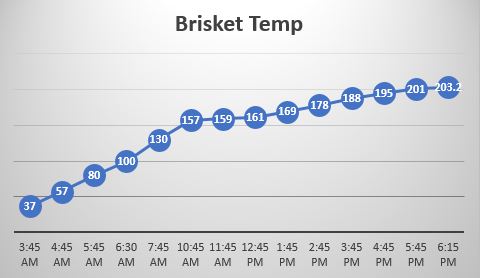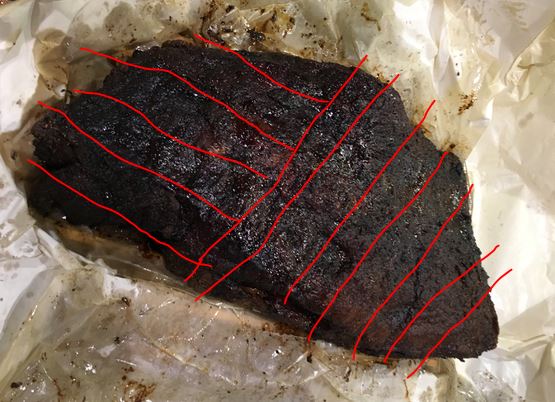Brisket -First Attempt

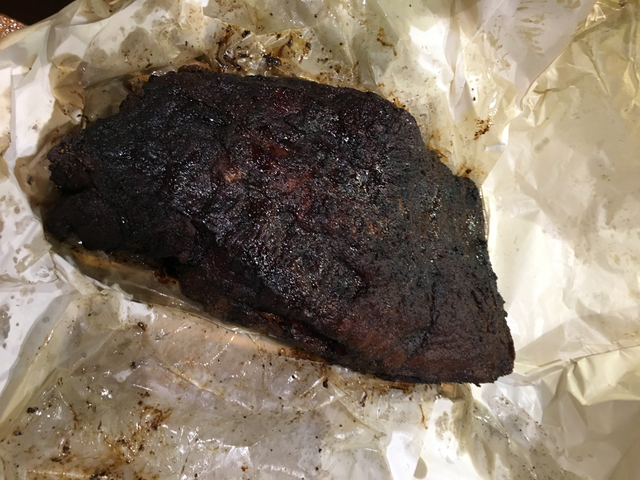
As much as I love BBQ, the gas grill has taken all the soul out of it. To me, I'd rather use the stove if I'm going to use a gas grill. These days when I BBQ, I use the Weber. It takes just a few extra minutes, and I'm never disappointed by the results.
That little bit of flavor tugged at me to get a smoker. Every time I pulled a rack of ribs, I'd think to myself, how much better it could be. Well the wait is over, I finally bought and smoked my first meal. As you know, I typically jump in with both feet, full force. So I smoked the hardest most stressful all day commitment I could think of -brisket!
At the end of the article, I'll most my notes from the day, here I'll cover the basics with a drill down of those steps.
Overview
Buy brisket, trim brisket, season at least 12 hours before smoking, smoke, rest, eat!, cleanup
I purchased an USDA Prime brisket from Costco. At $2.99 a pound, it's the cheapest 20 pound piece of beef I've ever bought. You can buy smaller portions of the brisket, flat or point, but I bought the whole brisket. For a consideration of grade, you're in good company with most decisions, a full list of who's who and what they use is detailed here.
Trimming the brisket was a bit overwhelming, it seems like it'll only get better with experience, yum.
If you've had my steaks, prime rib or even a hamburger, here's the secret rub -salt & pepper. Truth be told, I like the taste of BEEF. I can appreciate your garlic injected apple cider vinegar methods, but why? I like the taste of BEEF. Oh, and do it at least 12 to 24 hours in advance. I don't even cover in the fridge, just put it back in.
I cooked my first brisket at 225-275 for 14.5 hours.
I then let it rest for an hour.
Cut each slice across the grain and serve individually to guests. Everyone should get a piece of bark (that's the crust with all the smoke wonderfulness) with there meat. Eat with lots of friends, hopefully they supply beer.
Cleanup happens at least a day later, everything is nice and cool and it's much easier to scrape grease then trying to mop it and getting burned.
Here's the details
Smoker Choice
I just bought a KBQ smoker, it's awesome!
The front page of their site says "Barbecue. Precisely." I think that pretty much sums up why I bought it, and exactly what I wanted in a smoker. The 2 major details I wanted in a smoker:
- Real wood burning, no pellets or chips
- Ability to control temperature without being a pit master.
Sure build quality, cost and a number of other items were considered, but at the end of the day, that's what I wanted.
Meat Choice
There's lots of cuts out there, but if and when I can find it and afford it, I but USDA Prime. I don't go for all the gimmicky sales names, I want to know I'm getting a good quality piece of meat.
Trim
I wanted to trim and apply the rub at least 24 hours in advance, I only got about 12 hours. Trimming the brisket is mandatory! Everyone loves bark (that brisket crust that forms from hours of smoking), and fat doesn't make great bark. Most people cut the fat off, so do it first, or else they'll be cutting off the best part. Second, regardless of popular thought, fat on the surface isn't going to keep your meat moist.
I trimmed about 3 pounds off my brisket. I did leave about a 1/4" of fat on the top, but I heavily removed most fat.
Rub
Like I said above, I use salt & pepper. There's things to know about both. For one, course of fine grain salt measure differently (fine grain salt packs more tightly than course). It's best to use weight. I go with a 50/50 salt pepper. I usually grind my own pepper a day or two before I need it. I don't want it too intense.
For a 20 pound brisket I used 150 grams (about 1/2 cup) of salt and the same amount of pepper. mix them together and put them in an old shaker. I like to pat the mixture into the meat as I shake it on. I usually keep the shaker at least a foot away. from the meat, to get even distribution.

Smoking Brisket
I started my day around 2:00 AM. Coffee was definitely high on the list, but I think a bottle for one of the twins came first. Either way, it's an early start. By about 2:45 AM I was building the starter fire. A full hour later, the smoker was burning real wood and fully up to temperature (I got distracted, smoker didn't take nearly that long). Next time I'll get a better image, but so you get an idea of 3:00 AM cooking.
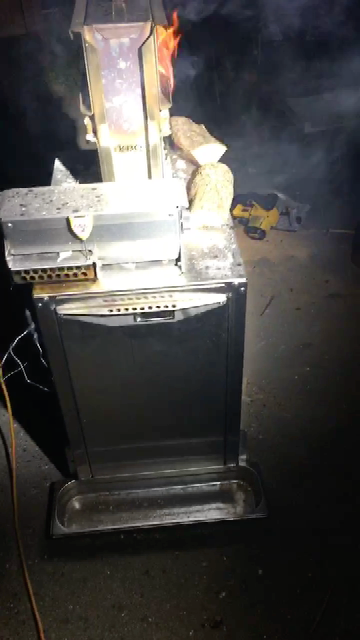
I tried to keep the brisket at 225. I had a continues meet probe and smoker temp. It also has a remote wireless handheld box, makes it simple to keep an eye on temps, from the couch. The ThermoWorks Smoke also has a magnetic back, love it! They only sell direct.
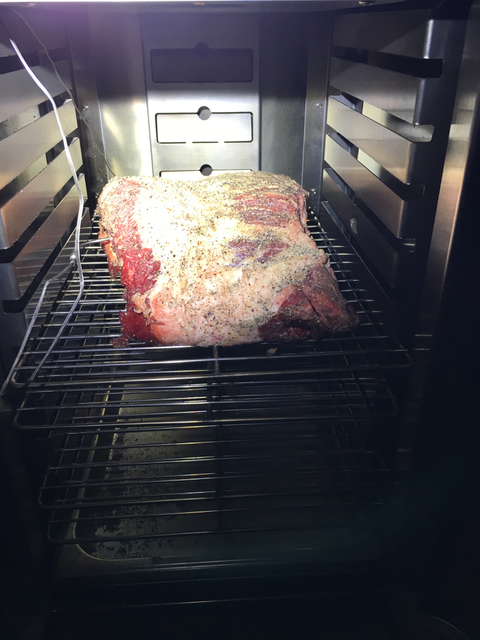
Another key, I put a pan of water at the bottom (see it in the picture?) of my smoker (inside the smoker) to keep humidity up. I also used a spay bottle to mist the meat starting about 4 hours in every 30 minutes or so. My smoker takes wood about every 25 minutes, so it was pretty simple, poke the fire, add wood, spray meat, relax.
After about 3 hours, I took my first peak. Here's what it looked like.

That process continued till the brisket exited the stall phase. I graphed my temps, so you can see what I'm talking about. See that flat section between 10:45 AM and 12:45 PM?
About an hour or so after the stall phase I wrapped the brisket in butcher paper, thank you Al's Market for the free butcher paper.
Toss it back in and continue to cook until it's done.
Realistically my brisket was likely done when it hit 200. They say anything between 200-212 is done, but it's 100% feel, so have fun with that.
I put the wrapped brisket back in a steam pan and then in a large cooler. It sat for an hour, next time I'll make sure it sits at least 2 hours.
Serving Brisket
Cutting meat is much more involved than you may think. Take the time to learn about how to cut brisket or any other cut. Your guests won't have a clue, but they will enjoy it even more.
Cooking is about getting all the details nobody knows about, right. Cut the meat across the grain, it'll chew better and therefore taste better.
The flat is the thiner section, it should be cut along the rise. The point is turned 90 and cut perpendicular to the flat. Here's a picture with an idea of the direction of cut.
Cut the flat at about 1/4", you can cheat and cut it thicker if it's over cooked to keep pieces from falling apart. The point is naturally going to need a thicker cut, and'll it'll probably still crumble a bit.
My 20 pound brisket fed about 20 people. We had lots of sides, most got tossed or ate the next day. Everyone ate brisket till they were stuffed and then sampled the sides with the little room they had left.
One last tip, serve brisket with an ale, pilsner or even better a farm style saison beer. It creates a wonderful contrast and cuts the heaviness of the meat.
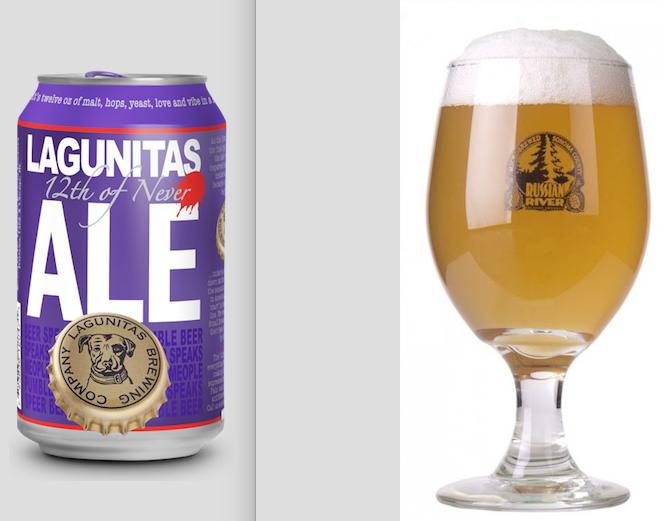
Enjoy with lots of friends, oh and be sure to share some with me.

